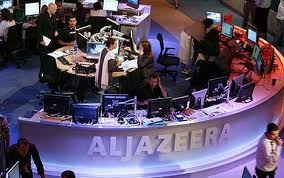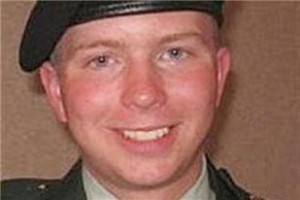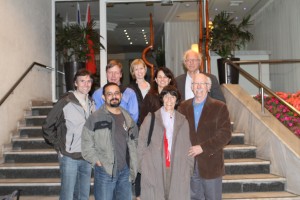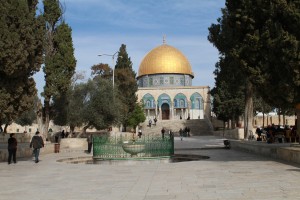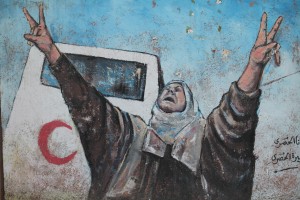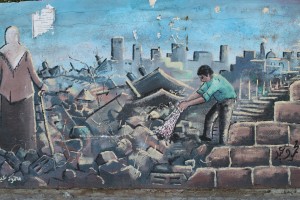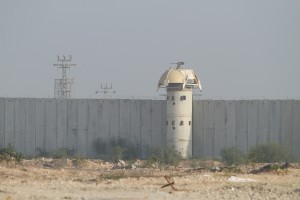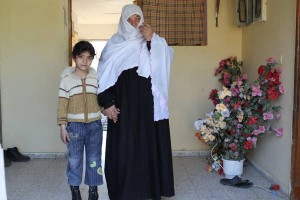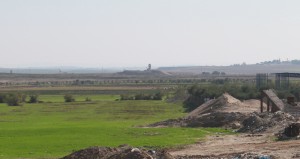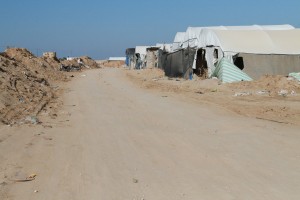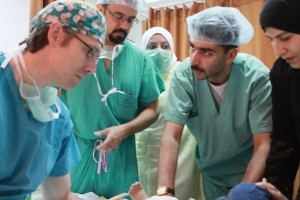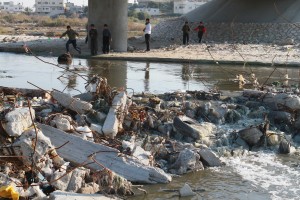WRITTEN BY AMAL SEDKY WINTER
To see more of Amal’s writing, go to her blog: “My Eye on Egypt.”
Cairo, Egypt
Tuesday, February 1, 2011
“I used to call them the spoiled brats of the internet,” one Cairo woman confessed. “Now I kiss their feet,” she said, referring to young men who broke the Egyptians long record of endurance under a dictatorial regime.
Today, the seventh day of the revolt against President Mubarak and for democracy in Egypt, 2 million people are said to be protesting in Cairo. Some have estimated 8 million nationwide; that’s ten percent of the population and that, technically speaking, is a revolution.
In Alexandria, the people are standing shoulder to shoulder from one end of that long city to the other.
It’s not the usual protestors; everyone knows them – like the Kifaya party (Enough) and the April 6 movement people.
No. This is everyone: we see huge clusters of women in their bright colored scarves – like a meadow in spring – and the men don’t even flirt with them because the ethic of protest is respect.
Crowds open up for people in wheelchairs and assist those walking with canes.
The people, once assured that the Army’s interest was in protecting them, fell into easy cooperation. Troops and people parade side by side, Egyptian flags raised. They work together to check people for weapons.
People who live near Tahrir Square cook for the protestors. In Helwan, south of the city, supplies of cooking gas ran out. Some of the young men in the area located supplies in a neighboring area and delivered them back to Helwan, door-to-door.
In the upsurge of pride, some protesters have pulled framed photos of Gamal Abdel Nasser, president of Egypt from 1956 until his death in 1970, off the walls of their homes and wave them above the heads of crowd – reminding their fellow Egyptians of the last time, during the pan-Arab movement, when they felt such self-respect and promise.
Everyone uses the same words of protest. Everyone is on message.
There is no doubt that Mubarak is leaving.
Power of the Army.
It’s true that the army has tremendous economic power in Egypt and that they may be thinking of their own interests as well as those of the people in allying with the protesters. But, in this country, the army is highly respected; it’s considered the institution of last resort and so far, they are deserving of that respect.
Furthermore, from a realistic standpoint, a revolution without their blessing wouldn’t succeed, if only because they hold that tremendous economic power.
Muslim Brotherhood, not.
The Brotherhood will not assume leadership. Contrary to what many westerners believe, they don’t have the influence – a fact seriously distorted by President Mubarak, who wanted to keep his U.S. allies nervous.
Amr Moussa interim leader?
Amr Moussa, whose term as head of the Arab League ends on Wednesday, could be the best choice for an interim leader. He’s 73, has spoken for the people for decades and has been treated accordingly by the regime.
The people know him and respect him. During the Africa Cup finals, President Mubarak appeared on the big screen to take credit from the players’ success. The crowds turned their flags down. When Moussa appeared, the flags flipped up.
America not looking good.
America is not looking good on the streets. If Secretary of State Clinton had spoken one day earlier, it would have been acceptable. Now the U.S. is seen as too little, too late.
We hear that the Americans are meeting with Mohamed ElBaradei, a big mistake. Here he’s perceived as being too far removed from the lives of the people, an impression he exaggerated by speaking to the people on television from the lush gardens of his residence.
Endurance of Egyptians
It used to be said that Egyptians can endure anything. If one revolution fails, the joke goes; Egyptians would shrug and say, “There’s always next century.”
This time is different. They’re using their capacity for endurance for their own benefit. Yes, food has run out in some places but, as with the cooking gas, people from other neighborhoods share.
Yes the doors of the shops are closed to prevent looting, but if you knock politely and say hello, they’ll let you in to shop.
Each challenge is met with a solution.
Each political disappointment is greeted with the response. “We’ll just stay longer.”
The mood is absolutely celebratory. People who have been disgusted by their country are standing up for it. They’ve stopped quarrelling among themselves for the few available spoils. In a class- and gender-segregated society, this is a stunning achievement.
Amal Winter is an Egyptian-American psychologist in Seattle who currently lives in Cairo, Egypt during the academic year where she is Visiting Professor of Practice at the American University in Cairo’s Graduate School of Education. She is a member of Psychologists for Social Responsibility, the Arab American Community Coalition in Seattle, and the Arab American Institute’s Pacific Northwest representative. Her numerous consulting positions include the U.S. Department of State where she trains women in the Middle East to run for public office and the creation of training programs for panels of mediation specialists in over 450 Egyptian family courts.
This article by Ryan Grim originally appeared at The Huffington Post, and is used by permission of the author.
WASHINGTON – Canadian television viewers looking for the most thorough and in-depth coverage of the uprising in Egypt have the option of tuning into Al Jazeera English, whose on-the-ground coverage of the turmoil is unmatched by any other outlet. American viewers, meanwhile, have little choice but to wait until one of the U.S. cable-company-approved networks broadcasts footage from AJE, which the company makes publicly available. What they can’t do is watch the network directly.
Other than in a handful of pockets across the U.S. – including Ohio, Vermont and Washington, D.C. – cable carriers do not give viewers the choice of watching Al Jazeera. That corporate censorship comes as American diplomats harshly criticize the Egyptian government for blocking Internet communication inside the country and as Egypt attempts to block Al Jazeera from broadcasting.
The result of the Al Jazeera English blackout in the United States has been a surge in traffic to the media outlet’s website, where footage can be seen streaming live. The last 24 hours have seen a two-and-a-half thousand percent increase in web traffic, Tony Burman, head of North American strategies for Al Jazeera English, told HuffPost. Sixty percent of that traffic, he said, has come from the United States.
Read more here.
By Amal Sedky Winter
To see more of Amal’s writing, go to her blog: “My Eye on Egypt.”
January 30, 2011
Cairo, Egypt
Today, the fourth day of what must now be called an Egyptian revolution, 100,000 people showed up in Tahrir Square, the political center of the people’s protest against President Hosni Mubarak and his government and for democracy and government respect of the people. Not a bare spot was to be found.
The size of the gathering was unaffected by the government’s shutdown of the internet and cell phone services. Nor the fact that it shut down Al Jazeera in Arabic, the county’s main source of news.
That fact is, that in spite of the tremendously rapid growth in internet and cell phone use in Egypt, the major pathways for news are mosques – whose messages sound throughout the city each day and which provide public gathering places for the people, and word of mouth.
Neighborhoods are extremely tight-knit; people help each other, lending money, bartering for services, adjudicating quarrels, offering aid and spreading news. Since very few move houses, the ties are long, complex and meaningful. Neighborhoods tie the country together. Word travels efficiently.
Mohamed ElBaradei
At some point, Mohamed ElBaradei, former Nobel Peace Prize winner and spokesman for authentic democracy in Egypt, announced that he would be willing to form an interim unity government.
The people’s opinion of ElBaradei is mixed. He’s been out of the country for decades, most recently as head of the IAEA International Atomic Energy Agency (IAEA), and many see him as an interloper and there are others with long established reputations for leadership and opposition to the government.
Still, in my opinion, it’s important now that a titular leader emerge. The people will get tired; they need people to replace those who were in positions of power and who are leaving the country in droves. Among many others, President Mubarak’s son, Gamal, often mentioned as a likely successor to his father, much to the people’s disgust, is said to be in London with his brother and their respective wives.
Meanwhile, the police have returned to the streets and protesters keep the pressure on one of main sites of oppression, like the Ministry of Interior (known locally as the Ministry of Torture). Today shots were heard from inside the building and there are rumors that the Minister abandoned the country.
F-16s over Cairo
Early this evening, my apartment rattled violently. Two F-16 fighter jets coming in low to buzz Tahrir Square. The people shout louder. In a phrase which rhymes in Arabic, they yell, “You fly; we stay!”
Army tanks rolls toward square while rumors spread that they had been ordered to use live ammunition and that they had refused.
I suspect that’s true. In Egypt, the army is thought of being on the side of the people. It would simply be “unEgyptian” of them to shoot.
Egyptians’ distaste for violence
People here are terribly upset by the violence. They genuinely hate to see people being hurt. They avoid confrontation. In fact, a major turning point in the revolt was provoked by government violence. In the beginning, the protest was mostly young middle-class men; but when the police started bruising, bloodying and in some cases killing, the lower classes joined up en masse.
And now, as this very dignified rebellion progresses, people are proud. For the first time in my life, I see real pride in their faces. They are proud of the consistency and restraint in the protest, proud of protecting their own neighborhoods.
I believe we’ll see a lasting change in the Egyptian psyche.
As an Egyptian-American myself, I am proud; I get shivers thinking about the folks out there.
Dr. Winter is an Egyptian-American psychologist in Seattle who currently lives in Cairo, Egypt during the academic year where she is Visiting Professor of Practice at the American University in Cairo’s Graduate School of Education. She is a member of Psychologists for Social Responsibility, the Arab American Community Coalition in Seattle, and the Arab American Institute’s Pacific Northwest representative. Her numerous consulting positions include the U.S. Department of State where she trains women in the Middle East to run for public office and the creation of training programs for panels of mediation specialists in over 450 Egyptian family courts.
RELATED
Key opposition leader, ElBaradei, joins demonstrators calling for Mubarak to leave
Rallies are held around the world in support of Egyptian demonstrators
Egyptian community in Seattle area plans protest
Images of Egypt in revolt (photos)
Turning a jaundiced eye toward the revolution
Social media fuels Egypt’s largest protest in years
Protests continue in Egypt, Yemen, while Algeria throws wheat at the fire
Follow the Arab protests online
From Al Jazeera, Saturday:
Egyptian president Hosni Mubarak has appointed the country’s head of intelligence to the post of vice-president, in a move said to be a reaction to days of anti-government protests in cities across the country.
Omar Soliman was sworn in on Saturday, the first time Mubarak appointed a vice-president during his 30-year rule. Ahmad Shafiq, a former chief of air staff, was also appointed prime minister.
But Al Jazeera’s correspondents in Egypt have said that many of those on taking to the streets have demanded a total change of guard, as opposed to a reshuffling of figures in the ruling National Democratic Party (NDP).
Tens of thousands of people in the capital Cairo gathered on Saturday, demanding an end to Hosni Mubarak’s presidency.
The demonstrations continued in defiance of an extended curfew, where state television reported will be in place from 4pm to 8am local time.
A military presence also remains, and the army warned the crowds in Tahrir Square that if they defy the curfew, they would be in danger.
Al Jazeera’s Ayman Mohyeldin, reporting from Cairo, said that soldiers deployed to central Cairo are not intervening in the protests.
Read the full report here.
Also, according to Al Jazeera, there are reports that the Egyptian President’s wife Suzanne Mubarak has left for London. Al Jazeera reported earlier that Mubarak’s two sons, Gamal and Ala, have fled to London with their families.
Meanwhile, the Associated Press reported Saturday that Egyptian security officials say at least 62 people have been killed nationwide over the last two days of mass anti-government protests.
The officials say an additional 2,000 people have been injured in the demonstrations, that have included violent clashes between police and protesters. They said Saturday the figures include injuries and deaths of both protesters and security forces.
The Associated Press is also reporting that relations between the army and the protesters are good right now. The 500,000-man military, which has given Egypt all of its four presidents since the monarchy was toppled in 1952 has enjoyed the respect of citizens who perceive it as the country’s least corrupt and most efficient public institution, particularly compared to a police force notorious for heavy handedness and corruption. It is touted as having defeated Israel in the 1973 Mideast War, and revered for that role.
The military, for its part, sees itself as the guarantor of national stability and above the political fray, loyal to both the government and what it sees as the interests of the general population.
But it remains to be seen what will happen if the troops are ordered to clear the streets.
Video of the street demos created by Tamer Shaaban, from You Tube:
“We will not be silenced, whether you’re a Christian, whether you’re a Muslim, whether you’re an Atheist, you will demand your goddamn rights, and we will have our rights, one way or the other! We will never be silenced!” – Protester in video
“Last night the Egyptian Dictatorship killed at least 53 protesters with Weapons given to them by America. That kind of “stability” is not worth protecting. Obama and Hillary are hypocrites. They’ve supported this murder for years and will support Mubarak until the day he is forced from power. As an American I am ashamed of my government. Long live the struggle of the Egyptian people!” – Comment on video’s YouTube page
From Russia Today online via You Tube:
Also today, Amnesty International sent out the following:
Thirty years of repression is spilling out onto the streets of Egypt in the forms of tear-gas, blood and bitter demonstrations. For four days, Egyptian protestors have suffered at the hands of President Mubarak’s security forces.
At least 14 protestors have been killed and scores more have been injured. The crackdown on freedoms is intensifying as authorities have cut all Internet and phone communications.
There’s no telling how long the violence will continue or how many people will suffer in the end.
The number one request we’re hearing from our fellow Egyptian activists is to have their voices heard at various Egyptian embassies and consulates.
We intend to do all we can to make that happen, but Egyptian authorities are making it very difficult. Our emails are not getting through and it will take far too long for our letters to reach anyone who can make a difference.
That is why we’re asking you to place an urgent call to the Egyptian embassy (202) 895-5400 and dial “1” to speak to a real person about the State of Emergency in Egypt.
Ask the person who answers the call to pass on this important message – and don’t take “no” for an answer: “Please urge the Egyptian government to respect human rights, rein in the security forces, and restore access to all communications in Egypt.”
Help us make the Egyptian embassy’s phone ring off the hook! Then tell us how your call went.
Three decades of living under the harsh and oppressive State of Emergency is unacceptable.
The people of Egypt deserve to have their voices heard and to organize peacefully. They deserve human rights.
(Sherwood Ross is a Miami-based public relations consultant and columnist. He has reported for the Chicago Daily News and worked as a columnist for wire services. His articles once appeared regularly in the Seattle Post-Intelligencer. This article originally appeared on the website of Media with Conscience and is used by permission of the author.)
The corrosive, solitary confinement being inflicted upon PFC Bradley Manning in the Quantico, Va., brig is no exceptional torture devised exclusively for him. Across the length and breadth of the Great American Prison State, the world’s largest, with its 2.4-million captives stuffed into 5,000 overcrowded lock-ups, some 25,000 other inmates are suffering a like fate of sadistic isolation in so-called supermax prisons, where they are being systematically reduced to veritable human vegetables.
To destroy Manning as a human being, the Pentagon for the past seven months has barred him from exercising in his cell, and to inhibit his sleep denies him a pillow and sheet and allows him only a scratchy blanket, according to Heather Brooke of “Common Dreams” (January 26th.) He is awakened each day at five a.m. and may not sleep until 8 p.m. The lights of his cell are always on and he is harassed every five minutes by guards who ask him if he is okay and to which he must respond verbally. Stalin’s goons called this sort of endless torture the “conveyor belt.”Not surprisingly, Manning is attracting global attention to the Pentagon’s sadism. If anyone did not believe the Pentagon’s ruthless treatment of Iraqi prisoners when the Abu Ghraib torture photos were released, they believe it now that it is torturing one of its own. In this assault upon the body and mind of a 23-year-old American soldier, all of the Pentagon’s arrogance and clumsiness is revealed to the world. Perhaps not even the French military – when its frame-up on treason charges of Jewish Colonel Alfred Dreyfus was exposed – attracted to itself the global searchlights of opprobrium now bathing the walls of a Marine Corps brig at Quantico.
The kind of isolation torture Manning is enduring in recent years has spread itself quietly throughout U.S. correctional facilities like a deadly gangrene. According to one reliable report, by 2003 between five and eight percent of the prison populations of Arizona, Colorado, Maine, Nebraska, Nevada, New York, Rhode Island, and Virginia were rotting in isolation. In some federal prisons the cells are referred to euphemistically as “Communications Management Units” and are, incidentally, “disproportionately inhabited by Muslim prisoners,” according to an American Civil Liberties Union(ACLU) law suit challenging them. In another suit, the ACLU has accused the Texas Youth Commission of “throwing children (girls) into cold, bare solitary confinement cells…” and told the TYC bluntly its “reliance on solitary confinement has to stop.”
Dr. Stuart Grassian, a veteran of 25 years on the faculty of Harvard Medical School, wrote in a law school journal of his interviews with prisoners in solitary. He said almost a third of them experienced impaired brain function. They “described hearing voices, often in whispers, often saying frightening things to them.” In an article published in “The Long Term View” magazine of the Massachusetts School of Law at Andover, Grassian wrote that about a third succumbed to “acute psychotic, confusional states” in which they saw objects “becoming larger and smaller, seeming to ‘melt’ or change form.” And this was only one of the syndromes experienced.
In a related article published in the same issue (Volume 7, No. 2), Dr. Atul Gawande of Brigham and Women’s Hospital, Boston, cited the findings of psychology professor Craig Haney of the University of California at Santa Cruz on isolation’s impact. Some inmates in the Pelican Bay supermax, Haney found, even after just months of isolation, suffered “Chronic apathy, lethargy, depression, and despair often result…In extreme cases, prisoners may literally stop behaving, becoming essentially catatonic.” This, of course, is what the Pentagon apparently seeks to inflict on Manning. In June, 2006, the Commission on Safety and Abuse in America’s Prisons recommended ending long-term isolation of prisoners but the so-called “House of War” wasn’t listening.
In the 2008 presidential race, Gawande wrote, both Obama and McCain came out firmly for banning torture and closing Guantanamo Bay prison where hundreds have been held in years-long isolation, yet neither “addressed the question of whether prolonged solitary confinement is torture.” McCain spent two of his five years as a POW in Viet Nam in solitary, later stating: “It’s an awful thing, solitary. It crushes your spirit and weakens your resistance more effectively than any other form of mistreatment.”
The U.S. willingness to hold prisoners in isolation for years “made it easy to discard the Geneva Conventions prohibiting similar treatment of foreign prisoners of war, to the detriment of America’s moral stature in the world,” Gawande wrote, adding, “In much the same way that a previous generation of Americans countenanced legalized segregation, our (generation) has countenanced legalized torture. And there is no clearer manifestation of this than our routine use of solitary confinement – on our own people, in our own communities, in a supermax prison…”
“This conduct (solitary confinement) by the U.S. Federal and State governments constitutes torture, cruel, inhuman and degrading treatment in violation of the Convention Against Torture and the International Covenant on Civil and Political Rights, both of which are treaties to which the United States is a contracting party,” says international legal authority Francis Boyle, professor of the subject at the University of Illinois, Champaign.
Boyle believes, “As citizens of America and human beings in the world, we must do all in our power to terminate such illegal and criminal practices that are daily perpetrated by our own governmental institutions in our name against our fellow citizens and human beings.” Boyle is the author of “Defending Civil Resistance Under International Law”(Amazon).
Those supporting Manning need to recognize he is an icon for the bizarre, systemic destruction of tens of thousands of other human beings locked away in perpetual silence by their tormentors, often for mere infractions of prison rules, without the review of any judge or jury. As the ACLU told the TYC, this must be stopped.
What action will you take in your community to put an end to it?
(This is Part 10 and the final story in this series. Gerri Haynes, a former president of Washington Physicians for Social Responsibility, has been sending back reports from inside blockaded Gaza. As she did twice before, Gerri organized a team of doctors and other health care providers to work in hospitals and clinics in Gaza in an effort to directly help the people there and to bring attention to the ongoing humanitarian crisis that the Israeli blockade has created.)
It’s snowing in New York. Our flight from JFK to Seattle has been cancelled and we are re-routed through Minneapolis. We sit in the snow-covered plane waiting de-icing and our turn at the runway – worlds away from Gaza, Bethlehem and Jerusalem.Our last day of this visit in Palestine/Israel moved us from Bethlehem to the Old City of Jerusalem and on to Tel Aviv to meet with members of Gisha and then Physicians for Human Rights, Israel. Before leaving for the airport, a young reservist lieutenant from the Israeli military joined us briefly. While on active duty, this thoughtful young woman had helped to expedite our permission to enter Gaza in October, 2009 and May, 2010. She is now enrolled in college. We thanked her for her help and wished her well with her studies.
Also, we visited with a young woman who has greeted us several times during our trips to the region – a woman we talk with in general terms about the views of moderate Israelis. Her views contrast with the views of Gisha and PHR, Israel. From representatives of these agencies, we heard strong Israeli concern about the situation in Gaza – recognizing that medical care is deeply compromised and that access to rebuilding the economy to afford better medical care is not now possible.
The collective punishment of the citizens of Gaza troubles nearly everyone we talked with in Israel. They indicate that the ethics of Israel are compromised by this imprisonment of 1.6 million people and are working to end the siege and find ways to assist the population.Tania, of Gisha, tells us that they are “working to give people the option to do what is right.” Neither Gisha nor PHR Israel holds political positions. Both agencies work on accessing assistance for the people of Gaza – with Gisha concentrating on movement of people and goods and PHR, Israel focusing on better access to medical care – for the people of Gaza and for immigrants to Israel.
Tania relates that Gisha provides legal and public advocacy i.e. provision of individual legal assistance with travel out of Gaza and public advocacy in the right/need to bring goods into Gaza. They are seeking to expand Israel’s criteria for movement.
In the past few years, Gisha has been successful in helping to bring some students out of Gaza to study – their publication of the ban on Gaza’s Fulbright scholars being unable to leave Gaza created awareness in the Israeli public and the ban was lifted.
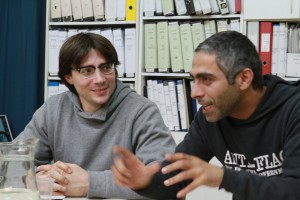
Staff from Physicians for Human Rights Israel discuss the problems with getting increased medical care for Palestinians. (Bob Haynes photo)
After the Flotilla in May, 2010 disaster, Israel announced a loosening of the ban on the entry of construction materials. Since June, 2010, a high of 137 construction-material trucks/month are entering Gaza – but all of this material is designated for use by international agencies such as the UN. Cement, steel and gravel are still not available through the crossings between Israel and Gaza for public use. This affects housing, schools, business, and employment – life in general for the people of Gaza. On the export side, there is an agreement for 400 trucks/day to leave Gaza i.e. with produce. The average before the siege was 70 trucks/day. This had dwindled to zero. Since June, with Israel’s announced loosening of the siege, 4.5 trucks/day have been allowed to leave. Again, the context of the numbers is important to consider.
There is an announced increase in permits for business people to move back and forth between Gaza and Israel. In context, each time one individual moves in or out of Gaza, this movement is counted as a permit. So, for example, if one official from the UN goes back and forth to Jerusalem every day for one week, this is counted as five permits – giving the impression that the number of permits has increased well beyond the actual number of people receiving permits.
Most students still go through the arduous (and frequently failed) process of transit through Rafah to Egypt. Most movement through Erez to Israel is for patients with critical medical needs and their companion i.e. a baby and mother. General travel between Gaza and the West Bank is almost completely banned.
Physicians for Human Rights, Israel worked in and out of Gaza until prevented by the siege. Their partners in Gaza provide PHR with information about medical needs and they work to assist with movement of patients. They also focus on the need to improve the environment of Gaza – the impact of polluted water, air and soil on the health of Gaza is of continuing concern.
The ultimate solution to the critical problems facing Gaza, they maintain, will be freedom of movement, access to needed goods and services and the ability of the people of Gaza to heal and care freely for their own population.
Members of this delegation are available to give presentations about this work. Please contact Washington Physicians for Social Responsibility at 206-547-2630.
(This is Part 9 in a series. Gerri Haynes, a former president of Washington Physicians for Social Responsibility, has been sending back reports from inside blockaded Gaza. As she did twice before, Gerri organized a team of doctors and other health care providers to work in hospitals and clinics in Gaza in an effort to directly help the people there and to bring attention to the ongoing humanitarian crisis that the Israeli blockade has created.)
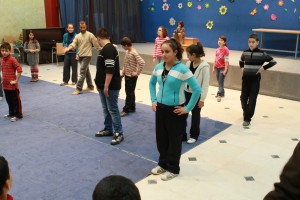
This center provides free access to books, art classes, music, dance, computers and study spaces for local children. (Bob Haynes photo)
As I pause to reflect on this visit, I know that the surgeons and cardiologist have seen scores of patients. The urologists have helped many children with complex surgical needs. Steve Gilbert has taught and discussed with hundreds of scientists – water, air and soil as polluted elements of the environment being their focus. The situation is grim.
I have talked with and counseled many women this visit – women whose desire it is to raise healthy, happy, secure children. Education is a primary value here. Schools are desperately overcrowded and children who are double-shifted go home to do their homework for three hours, then spend four or five hours with one or both parents – extending their learning.
Still, as the threat of attack is constant and the reality of extreme pollution is inescapable, the women I have talked with despair over the future for their children. The high unemployment rate means frustration and humiliation for men who cannot provide economic security for their families.
Turmoil in families is familiar and carries deep sorrow. The prospect of no resolution of the conflict between Israel and Palestine and of the internal Palestinian conflict means a future that stretches bleakly into an uncertain time.Young, bright Gazans express hope that the conflicts will end in a positive way when new leadership comes to power – the mothers I talked with only shake their heads and say, “God willing.”
One spectacularly bright light in Gaza is the Qattan Center for the Child. Funded by Mr. Qattan, a wealthy gentleman from the Gulf, the Center provides free access to books, art classes, music, dance, computers, study spaces and community for local children. Reem Abu Jaber, director of the Center, says she was born for this joyful work in an oasis of hope.
We have bid farewell to many friends in Gaza. The hardworking team of Amani, Marwan and Ashraf from Gaza Community Mental Health Programme has once again organized our days and made certain we were able to work as efficiently as possible.
It is late at night in Gaza. Dr. Ismail Zamilpa and Johanna Longacre, operating room nurse, are still in surgery.
UPDATE:Monday evening, Bethlehem
It took only two and one half hours to pass our delegation through the Erez Crossing from this morning.
There were some questions, but we were greeted by an official of the crossing who told us they want to make the crossing more open. He would like to see more commerce and workers passing through the checkpoint and says that they have opened the crossing at all hours to assist people coming from Gaza who have medical needs, even on Fridays.
We asked him about the reason more patients aren’t allowed to pass to the West Bank for care and he told us that government of Gaza denies people permits to pass from Gaza, often until they are near death. The differences in reasons for delays vary with each person who speaks of them, but everyone agrees that the borders create enormous difficulties for the Palestinians who live in Gaza.
We stopped for lunch with an old friend in Jerusalem, Hillel Schenker, co-editor of the Palestine/Israel Journal. Hillel spoke of continuing hope for peace and told of several peace initiatives and groups that are working to resolve the impediments to peace.
In Bethlehem, we toured the Rehabilitation Hospital, a beautiful facility that provides surgical care and rehabilitation to people from the West Bank and Gaza.The hospital’s medical director and told of expanded services and excellent care. We stood on the roof of the hospital and viewed the Separation Wall as it is being constructed close to the hospital, bisecting the Beit Jala area near Bethlehem from the open lands once included in this area – lands containing Palestinian olive groves and agricultural areas that will be inaccessible to the owners of the land.
We spent this evening in the offices of Wi’am, the Palestinian Conflict Resolution Center. We were treated to a homemade Palestinian dinner and listened to Yahav, a representative of the Israeli Center Against Housing Demolitions as he briefed us on the history of conflict here and spoke of possible resolutions. This is the organization headed by our friend, Zoughbi Zoughbi, and we heard of some of the excellent work the staff of Wi’am is doing in conflict resolution, women empowerment, child support and community negotiations.
The hopes for peace are strong.
(This is Part 8 in a series. Gerri Haynes, a former president of Washington Physicians for Social Responsibility, has been sending back reports from inside blockaded Gaza. As she did twice before, Gerri organized a team of doctors and other health care providers to work in hospitals and clinics in Gaza in an effort to directly help the people there and to bring attention to the ongoing humanitarian crisis that the Israeli blockade has created.)
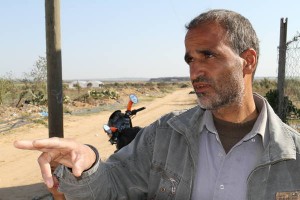
Nabil once had a home in an area of conflict in southern Gaza. It was destroyed but he still visits some of his land just to tend crops. (Bob Haynes photo)
A team of doctors from the Advanced Mobile Clinic of PMRS has traveled to see patients in an area near Rafah very close to the “no-go” zone across from the border with Israel. No other medical teams serve this dangerous agricultural area. On a regular basis, rockets leave and missiles enter. During Operation Cast Lead (2008/2009), 200 homes were destroyed here.
Nabil’s home is gone; his leg was injured during the attacks by Israel, but he appears to have recovered. Now, he travels from his brother’s home in Khan Younis every day to tend the crops he has replanted. Even so, much of his land lies to the east in the area forbidden to him by Israel.
For the 2,000 people who live in damaged or make-shift homes in this area, the possibility of being caught in the middle of lethal conflict is constant.
Nabil says, “We are suffering from everything, not just health, water, lack of security – everything.”
He gives us this example: A child living here developed a high fever. The parents called for an ambulance but they were told that an ambulance cannot come to this area in the night – they would have to walk to a place of care (miles away.) There are no police in this area to protect them.
As we walk West of the clinic, we are greeted by Um Suhail. She greets Dr. Mohamed warmly and invites us to visit her home. Outside her bullet-riddled home, there is a pen containing several beautiful birds. I watch and listen to them and Dr. Mohamed says, “These people love life.” Um Suhail tells us, “The Israelis do not allow us to be in the life. Sometimes they open fire on us when we sit here with our family at night. We are suffering from both the Israelis and the Palestinians because the rockets fill the area. I told the Israelis that we do not support Hamas or Fatah. One Israeli soldier told me that I must support Hamas by my vote – that all Gazans are Hamas. We are suffering a lot.”Next to Um Suhail’s house, we see a large rectangular pool lined with plastic. Water for irrigation is collected here and a series of plastic irrigation pipes has been constructed by a business man from Rafah – providing water for the olive and fruit trees, peas, cabbage and cauliflower grown here.
There seems to be awareness that the soil may be contaminated by unclean water as well as by toxins from the white phosphorus and other agents used during Cast Lead and since, but crops are needed. Because unemployment in Gaza is extreme (we have heard from 45-80 percent, depending on the ages included in the statistic), sale of produce is limited and incomes from farming are very low.
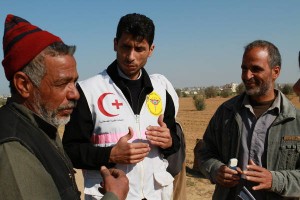
Abu Hani, left, also had a home in the zone that was destroyed by Israel. He tells Dr. Mohamed, center, and Nabil that he still works his nearby land despite the daily danger from Israeli attacks. (Bob Haynes photo)
He says, “I spend my time in the land. The market is very weak and export is impossible under the siege. People have nothing and there is no work in Gaza for my son or family. The main problem is the siege and the occupation. Some NGOs help by giving us saplings for our orchards, but no money. I have a son in an Israeli prison. He has been there since he was kidnapped from his home following the capture of Gilad Shalit. He is married and has one daughter and one son. I have not seen him for four years. The Red Cross gives him messages from us every four months – we tell him we are well and he tells us he is suffering.”
Abu Hani continues: “The land is ill because of the war. There are poisons in the soil. The harvest of olives and grapes is low. Before the attacks, my harvest was big. Now even the rain is less. But the main problem is the siege. We are peaceful people. We like peace. We hate war. I hate the attacks and the destroying of my home and my land. War and the attacks mean killing and destroying and this affects me as a person. Israelis make rumors that Gazans are terrorists, but we like peace. If the gate is open, I would like to send my son to Germany to study. Please tell your people, tell your family, that you met peaceful people in Gaza.”
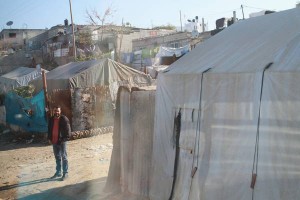
The Israeli blockade, among many other things, has created a dire shortage of construction materials. Gazans make do with tents, plastic, mud and whatever else they can. (Bob Haynes photo)
Dr. Mohamed tells us these people do not register on a poverty scale, their poverty is so great. Still, we are met by the smiling and gracious Fatima, a woman known to Dr. Mohamed as a patient. She speaks to us of her life and invites us into her home – a cement rectangle divided into an empty room for gathering, four bedrooms leading directly from the empty room, and a tiny cooking area. More than twenty people live in this space. Married sons and their families each have one of the small bedroom with as many as seven people per room. Before we leave, Fatima insists on serving us cola,- then hugs and kisses us “Good-bye.”

Smiling and gracious, Fatima, a woman known to Dr. Mohamed as a patient, welcomed the group into her tiny home, which was shared with more than 20 other members of her extended family. (Bob Haynes photo)
The young man tells us that his father left the family and now it is his responsibility to feed this family of six. Because there are extremely few employment opportunities in Gaza, the family often goes without food. Last week, he says, they had no food for three days.
UNRWA helps them every three months, but what they receive is not enough to last and they are often hungry.
Dr. Don Mellman writes this blog: As a neurosurgeon, I have a “private practice” in Gaza. There are patients who learn of my being here and make individual arrangements to be seen. One patient was seen in his home on our last visit to Gaza and I will see him again before we leave… house calls in Gaza.
Besides consulting in surgery, Don has provided consultation in the intensive care unit and will consult in the neurosurgery clinic at Shifa hospital. This is a clinic for problem cases in neurosurgery.
Because of his experience working with neurosurgeons in Gaza, Don says he has great respect for and a very high opinion of their knowledge, skills, judgment and ability to work under extremely adverse conditions.
In keeping with the Islamic holy day, medical clinics and operating rooms are closed on Fridays. Our group took this day to travel the periphery of Gaza.
Gaza is a small land – approximately 25 miles long and 3 – 7 miles wide. All borders of Gaza are closed to free passage. To the north and east, borders are marked by Israeli-imposed no-access zones (areas whose boundaries are not clearly marked).
Each week, according to a UN spokesperson, people who farm near these areas are fired on by Israeli soldiers and wounded or killed – often well outside the understood boundaries. Vast acres of land, once used for supplying food for local use and for export have been rendered inaccessible and dangerous.
The border with Egypt is marked by a “no-man’s land”. To the sea, Gazans are prohibited by Israel from traveling into deep water. As we drove, we noted armed Israeli guard towers in the near distance and the reality of Gaza as a prison was clear.
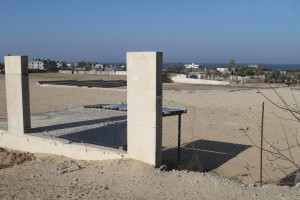
The American International School once stood on this site. It had been attacked before by Israel, but was completely destroyed in Israel's Operation Cast Lead. (Bob Haynes photo)
Following the Flotilla disaster in May, 2010, outcries from the international community demanding that Israel end the siege on Gaza were met by a minimal increase in transferred goods.
For people, there is no free passage in or out of Gaza. Select permission is granted to a minimal number of people i.e. those with critical medical care needs may sometimes travel for care to the West Bank through the Israeli check point at Erez. Also, limited numbers of people – those having gained hard-sought permission – are allowed to transit through the Rafah check point into and out of Egypt. Both of these check points operate on limited hours and limited days.
Throughout our travels to the north and east today, the destruction of Gaza by Israeli attacks is visible. Entire areas where homes and industrial plants once stood are now empty.
Prohibition of access to rebuilding materials is evident – temporary structures of metal and plastic now house thousands of people.
We visited the area of tunnels at the southern border Gaza in Rafah. At the high point of tunnel traffic, 1,000 or more tunnels were in use. We heard that approximately 150 tunnels are active today – carrying goods at an inflated price and at great danger.
Reaching 30 meters into the sandy earth, the tunnels are fragile. On Wednesday of this week, while talking with medical students, Bob Haynes learned that earlier that day, two young men were crushed by a tunnel collapse. Over 200 people have died in the tunnels. Open commerce with Israel could end the need for tunnel traffic.Last evening, we were given a preview of what we would see today. We were invited to the home of a local scientist. Near the border with Israel, this family’s lovely home was occupied for 18 days during the 2008-2009 attacks.
Eleven family members survived in one small room of their home while soldiers commandeered the rest of the house. Tanks destroyed entry stairs, partial walls and much of the home’s yard. Areas where bullets tore through the walls of the master bedroom remain scarred. A family car, destroyed by an Israeli bulldozer, is a now a lump of metal.
Again and again, our host commented how thankful his family is to be alive and correctly forecast that today we would see that many in Gaza were not so “fortunate.”
(This is Part 6 in a series. For the next several days, Gerri Haynes, a former president of Washington Physicians for Social Responsibility, will be sending back reports from inside blockaded Gaza. As she did twice before, Gerri has organized a team of doctors and other health care providers to work in hospitals and clinics in Gaza in an effort to directly help the people there and to bring attention to the ongoing humanitarian crisis that the Israeli blockade has created.)
Complex surgeries awaited the pediatric urology team when we arrived in Gaza. For Richard Grady, Ismael Zamilpa and Johanna Longacre, each day is filled with opportunities to help some of Gaza’s children. As they operate, the team is also teaching a group of local surgeons.
Members of our group accompanied Steve Gilbert for a tour of toxic sites in Gaza. Scientists demonstrated for us the challenges of dealing with the flow of sewage.One temporary plant for partial treatment of sewage was said to provide a variable percentage of treatment for a small fraction of the sewage in the Khan Younis area. At best, the sewage in this area is 80% clear prior to entering the sea.
When the daily break in electricity occurs, sewage flows untreated into the Mediterranean. Permission is needed from Israel to site a treatment plant in the clay soil near Gaza’s eastern border.
Access to building materials and reliable electricity are essential if permanent solutions are to be found to the crisis in sewage management. In the meantime, the soil and the sea continue to be heavily contaminated.
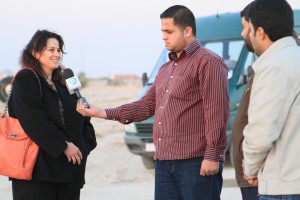
Laura Hart being interviewed about what we have learned about the environment in Gaza. (Bob Haynes photo)
Continuous Traumatic Stress Injury (not PTSD) is experienced by all people here, including the health care providers. When an Israeli war plane flies overhead, people feel anxious.
Threats of further attacks are noted frequently in the international press. One student mentioned that her son asks her every day if they are going to be bombed again. This student asked how she should answer her son – should she tell him not to worry or should she be more honest.
I suggested that families sit together and talk about their hopes for no more attacks, to remember the helpful things they did to deal with the last attack and then to formulate a plan in case another attack occurs.
Working together, the class described a list of items that might give their families a sense of being better prepared. Faith in God and the strength of family groups were cited as crucial to survival here.Resilience is the lesson Gaza will teach the world.
